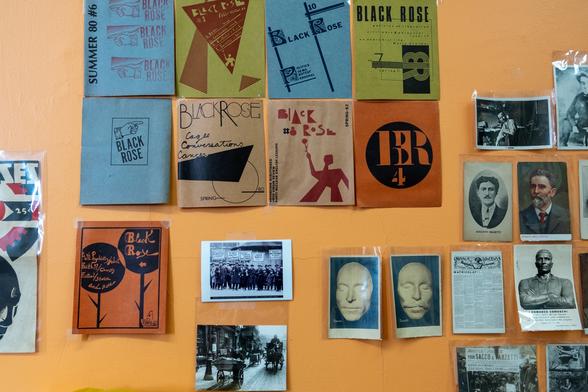Cool Kids Snack Cakes has been added to A Radical Guide https://www.radical-guide.com/listing/cool-kids-snack-cakes #WhereWereYouRadicalized #MutualAid #DirectAction #RadicalEducation #radicalhistory #GrassrootsMovements #Solidarity #Abolition #Antifascism #RadicalHistory #SupportRadicalSpaces #CollectiveLiberation #MovementBuilding #anothetworldispossible #grassrootsactivism #liberation #northamerica #unitedstates
Recent searches
Search options
#radicalhistory
Do you know the story of #Jagdvej69 in #Copenhagen? It was build as a #socialist #FolketsHus 1897. 1910 a international womens Conference of decided for the #internationalwomensday in this building.
1982 it was #squatted and became the @Ungdomshuset . 2007 it was evicted after it had been bought by an #evangelikal sect.
So for 18 years now the #Ground69 is empty.
#radicalpast #radicalhistory #socialism #squatting #punk #graffiti #Nørrebro
@folketshus
I am thinking about working on a #book about this building in #german. I don't speak #danish. My first Idea was to translate this one: https://search.worldcat.org/de/title/kampen-om-ungdomshuset-studier-i-et-oprr/oclc/488358772
But maybe it would be good to have a new concept.
If you are interested in the Idea and maybe could help, please contact me. Actually, I am in Copenhagen till tomorrow.
https://en.m.wikipedia.org/wiki/Ungdomshuset
Black Swan Socialists has been added to A Radical Guide https://www.radical-guide.com/listing/black-swan-socialists #WhereWereYouRadicalized #MutualAid #DirectAction #RadicalEducation #radicalhistory #GrassrootsMovements #Solidarity #Abolition #Antifascism #RadicalHistory #SupportRadicalSpaces #CollectiveLiberation #MovementBuilding #anothetworldispossible #grassrootsactivism #liberation #australia #perth
Dandelion DIY has been added to A Radical Guide https://www.radical-guide.com/listing/dandelion-diy #WhereWereYouRadicalized #MutualAid #DirectAction #RadicalEducation #radicalhistory #GrassrootsMovements #Solidarity #Abolition #Antifascism #RadicalHistory #SupportRadicalSpaces #CollectiveLiberation #MovementBuilding #anothetworldispossible #grassrootsactivism #liberation #bristol #unitedkingdom
Really Really Free Market Corvallis, Oregon has been added to A Radical Guide https://www.radical-guide.com/listing/really-really-free-market-corvallis-oregon #WhereWereYouRadicalized #MutualAid #DirectAction #RadicalEducation #radicalhistory #GrassrootsMovements #Solidarity #Abolition #Antifascism #RadicalHistory #SupportRadicalSpaces #CollectiveLiberation #MovementBuilding #anothetworldispossible #grassrootsactivism #liberation #corvallis #oregon #unitedstates
BASE Social centre has been added to A Radical Guide https://www.radical-guide.com/listing/base-social-centre #WhereWereYouRadicalized #MutualAid #DirectAction #RadicalEducation #radicalhistory #GrassrootsMovements #Solidarity #Abolition #Antifascism #RadicalHistory #SupportRadicalSpaces #CollectiveLiberation #MovementBuilding #anothetworldispossible #grassrootsactivism #liberation #bristol #unitedkingdom
"Poster from an Antiwar, Lesbian, Feminist Fugitive, ca. 1970." Details, including alt text, at https://markstoneman.com/2025/03/14/poster-from-an-antiwar-lesbian.html #WHM #RadicalHistory #OldPosters
"A New Era for Women Workers, Minority Women and Lesbians." 1976 poster by a Seattle organization called Radical Women.
Via Library of Congress, Yanker Poster Collection, https://www.loc.gov/pictures/item/2016649885/.
#WomensHistoryMonth #WHM #Intersectionality #Seattle #RadicalHistory
this Sunday at 2pm, come to the Lucy Parsons Center to find inspiration from Boston's radical history. free!
myself and jay c will be your tour guides on this voyage...
a new, long-form article on preserving the story and legacy of local Italian-American anarchists, Sacco and Vanzetti...
#Sacco #Vanzetti #SaccoAndVanzetti #BostonMA #RadicalHistory
https://www.thecrimson.com/article/2025/2/13/sacco-vanzetti-archive/

if you're looking for some inspiration, why not come to the Lucy Parsons Center on Sun. 2/23 at 2pm to learn about Boston's radical history? FREE FREE
Myself and Epic Jay Colbert will be your guides...
Occult Black History Month
did you know the most powerful practitioner in New Orleans history worked as a hairdresser?
Marie Laveau (1801-1881) knew something most modern occultists forget; real power flows through networks of whispered secrets, shared struggles, and strategic silence. while she's remembered as the Voodoo Queen, her true genius was in understanding that liberation requires both spiritual and earthly power.
her salon wasn't just a business... it was command central for an intelligence network that would make modern hackers jealous. rich white women's secrets flowed freely under her hands, while her spiritual services gave her access to every level of society. she didn't need encrypted channels when she had a city's worth of devoted eyes and ears.
she walked freely through a violently segregated city, entered prisons at will, and made both governors and slaves tremble at her name. not through elaborate rituals or fancy grimoires, but through a perfect fusion of practical cunning and spiritual authority.
the history books want you to see her as some exotic mystery, all snake dances and gris-gris bags. they don't want you thinking too hard about how a free Black woman built an empire of influence in the antebellum South, or why the powerful feared her while the oppressed sought her protection.
they definitely don't want you thinking about how she used that influence. she secured pardons for the condemned, protected fugitive slaves, healed the sick regardless of race or status, and maintained a power base that lasted decades in a time when most Black women couldn't even own property.
she understood something fundamental about power. it's not just about what you can do, it's about what people believe you can do. every rumor of her abilities, every whispered story of her influence, every public display of her authority... all carefully cultivated tools in a arsenal of liberation.
her greatest trick? convincing the powerful she was just entertaining while building networks of resistance right under their noses. she didn't need to hide in shadows, she made herself so visible they couldn't see what was really happening.
that is just amazing shadow/void work. funny how they focus on the rituals and ignore the revolution beneath them. there's a lesson there.
next time someone tells you to keep your spiritual practice 'pure' and separate from politics, remember Marie. she knew that real power isn't about keeping your hands clean, it's about using every tool at your disposal to protect your people.
dear diary,
last night, at a potluck, i hung out with Jim O'Brien. Jim wrote for "Radical America" in the 70s, was a friend to Detroit's legendary radical printer/writer Fredy Perlman, & was a member of the cooperative New England Free Press (which was the original publisher of Our Bodies, Ourselves)
and yes, i totally fan-boyed him with questions and questions and questions
#TheRealNewsNetwork #TRNN #TheMarcSteinerShow with guest #MollyCrabapple
#JewishLabourBund, a secular and antizionist party
Anti-Zionism has existed since the beginning of Zionism
IWW Clydeside
@clydeside
This Sunday 30th June at 12 noon, open invite to have a stroll/meander around #GlasgowGreen
Let the #Scottie (dog) into a parkie !
#edinburgh #scotland
Sunday 7th July:
Doin' the Lambeth Walk: free #RadicalHistory walk round North Lambeth:
https://radicalhistoryfaction.wordpress.com/2024/06/06/doin-the-lambeth-walk-oi/
Lots of cool contemporary work & radical history (#suffragettes!)
Special mention to this beautifully-illustrated Manchester Uni project “Teenage Kicks: Girls Growing Up in Britain 1956-1974”, which we spent quite a while watching
Marxism & anarchism in the 1920s-30s
"Marxism overtook anarchism on the Left in response to both economic developments and the Russian Revolution. Syndicalist forms of the anarchist struggle had proliferated within the nascent industrialization of the early twentieth century. While anarchism had a stronger working-class base than often presumed, it flourished in the relatively informal production conditions of this period. As federated anarchist labour unions began to challenge the rule of capital, capitalists responded by centralizing and formalizing production—in part to break the power of syndicalist unions. This formalization provided fertile ground for Communist Parties to organize centralized unions.
In addition, anarchists were unable to offer a satisfactory response to the global depression of the 1930s. Anarchism provided little alternative to the popular-national forces that took power— including [FDR]'s New Deal Democrats in the United States, Lazaro Cárdenas’s agrarian reforms in Mexico, and the popular front government in Chile—all of which were supported by their respective Communist and Socialist Parties.
Yet even in countries where anarchism seemed to disappear after the early 1930s, such as Mexico and Argentina, the tenets and ideals of anarchism lived on in libertarian currents within Communist Parties and within the everyday lives of ordinary people fighting for freedom, equality, and self-determination."
Revisiting my article "Radical Americas: A Hemispheric History of the Left" in Left History: An Interdisciplinary Journal of Historical Inquiry and Debate as I prepare a lecture on Latin American anarchism https://lh.journals.yorku.ca/index.php/lh/article/view/39672
New on "Anarchist Nerdvana": Dive into the Haymarket affair with "Anarchy and Anarchists" by Michael J. Schaack. Host Jason Bayless explores this radical artifact, blending history with the joy of nerd culture.
Listen now: https://www.radical-guide.com/anarchy-and-anarchists-anarchist-nerdvana-episode-one/ #AnarchistNerdvana #RadicalHistory #NerdCulture
"Reproductive rights were won by grassroots feminist movements working in conjunction with electoral and legal strategies.
Doctors, lawyers, and even many clergy spent decades fighting legal battles to lift restrictions on abortion and birth control. Like today, they often limited their focus to cases based on health concerns or rape, rather than arguing for the fundamental right to bodily autonomy and reproductive freedom.
These tactics laid the legal foundation for Roe v. Wade, particularly the Supreme Court’s 1965 decision in Griswold v. Connecticut that legalized birth control for married couples based on the right to privacy. Yet this reliance on the framework of privacy limited the scope of reforms by obscuring the actual fight for reproductive freedom and bodily autonomy. It was only with the birth of a militant feminist movement that fought to repeal all laws restricting abortion that there was substantive progress regarding abortion itself at the level of the state.
Radical feminists in the 1960s-1970s employed new strategies for building power and effecting change. Feminists in the Women’s Liberation Movement, many of whom were veterans of the anti-war movement and New Left organizations like Students for a Democratic Society, began forming autonomous women’s groups in the late 1960s. They organized consciousness raising groups across the country in which women discussed their shared experiences.
This provided the foundation for women to speak out publicly about their abortions and to openly fight for the repeal of all abortion restrictions. Feminists began disrupting male-dominated medical spaces and challenging their supposed expertise. The Redstockings led the way when they spoke out at a 1969 New York State Joint Legislative Committee Hearing and proclaimed that “the only real experts on abortion are women!”
In addition to speakouts and demonstrations, feminists also built grassroots women’s infrastructure including underground abortion networks. Women across the country took reproductive care into their own hands, including through the new at-home abortion technique of menstrual extraction that was developed in 1971.
Feminists were inspired to put into practice what they learned from the Boston Women’s Health Book Collective’s landmark text Our Bodies, Ourselves (1970). The Chicago Jane Collective, for instance, performed over ten thousand illegal abortions between 1969-1973. Feminists demanded the repeal of all abortion laws and advocated for women themselves—not the state or the male-dominated medical system—to control their bodies.
Feminist scholar-activist Jenny Brown argues that it was these “massive feminist mobilizations” which “brought hundreds of thousands into the streets,” alongside consciousness-raising and underground abortion provision, that “in just four years forced a reluctant Supreme Court to legalize most abortions across the country.” Militant mobilization and widespread public disobedience, in combination with ongoing legal cases, pressured the Court into codifying limited abortion rights into law in the 1973 Roe v. Wade ruling."
Read more in my recent article in Radical History Review, "'To Repulse the State from Our Uteri': Anarcha-feminism, Reproductive Freedom, and Dual Power"




